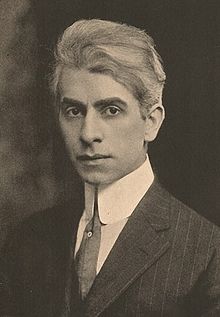Franklin Booth
| Franklin Booth | |
|---|---|
 |
|
| Born |
Jay Franklin Booth July 8, 1874 Carmel, Indiana |
| Died | August 25, 1948 (aged 74) New York, New York |
| Resting place | Old Carmel Cemetery, Carmel, Indiana 39°59′10″N 86°07′34″W / 39.986°N 86.126°W |
| Nationality | American |
| Education | |
| Known for | Illustrations |
| Awards | Society of Illustrators Hall of Fame 1983 |
Franklin Booth, (July 8, 1874 – August 25, 1948) was an American artist known for his detailed pen-and-ink illustrations. He had a unique illustration style based upon his early recreation of wood engraving illustrations with pen and ink. His skill as a draftsman and style made him a popular magazine illustrator in the early 20th-century. Creator of the Nicholson plate, he was one of the first modern ex libris designers in the United States.
Using watercolor, Booth created book illustrations, such as James Whitcomb Riley's The Flying Islands of the Night. During World War I, he created posters for recruitment, fundraising, and other efforts. As Art Deco style illustrations became popular, his work in latter years was found in commercial publications and catalogs. Although he "believe[d] in schools to a certain extent" at one point in his career, he co-founded the Phoenix Art Institute and was an educator for 21 years. He was inducted into the Society of Illustrators Hall of Fame.
Jay Franklin Booth was born in 1874 and raised on a farm near Carmel, Indiana. His parents, Susan Wright and John Thomas Booth, had eight children. Booth, the third child, attended the Quaker Academy at Westfield.
As a boy, he was determined to become an artist. He studied pictures in books and magazines, including Scribner's and Harper's. His unusual technique was the result of his having scrupulously copied magazine illustrations which he thought were pen-and-ink drawings. In fact, they were wood engravings. As a result, this led him to developing a style of drawing composed of thousands of lines, whose careful positioning next to one another produced variations in density and shade. The characteristics of his art were his scale extremes with large buildings and forests looming over tiny figures, decorative scrolls and borders, classic hand lettering and gnarled trees.
He expressed his view of formal education, "I believe in schools to a certain extent, yet I think a knowledge of art is not a thing held in trust by any, but is, rather, universal and comes to them who hunger and thirst after it." He took a correspondence course in art while he lived in Indiana, and studied for three months each at the School of the Art Institute of Chicago and the Art Students League of New York.
...
Wikipedia
